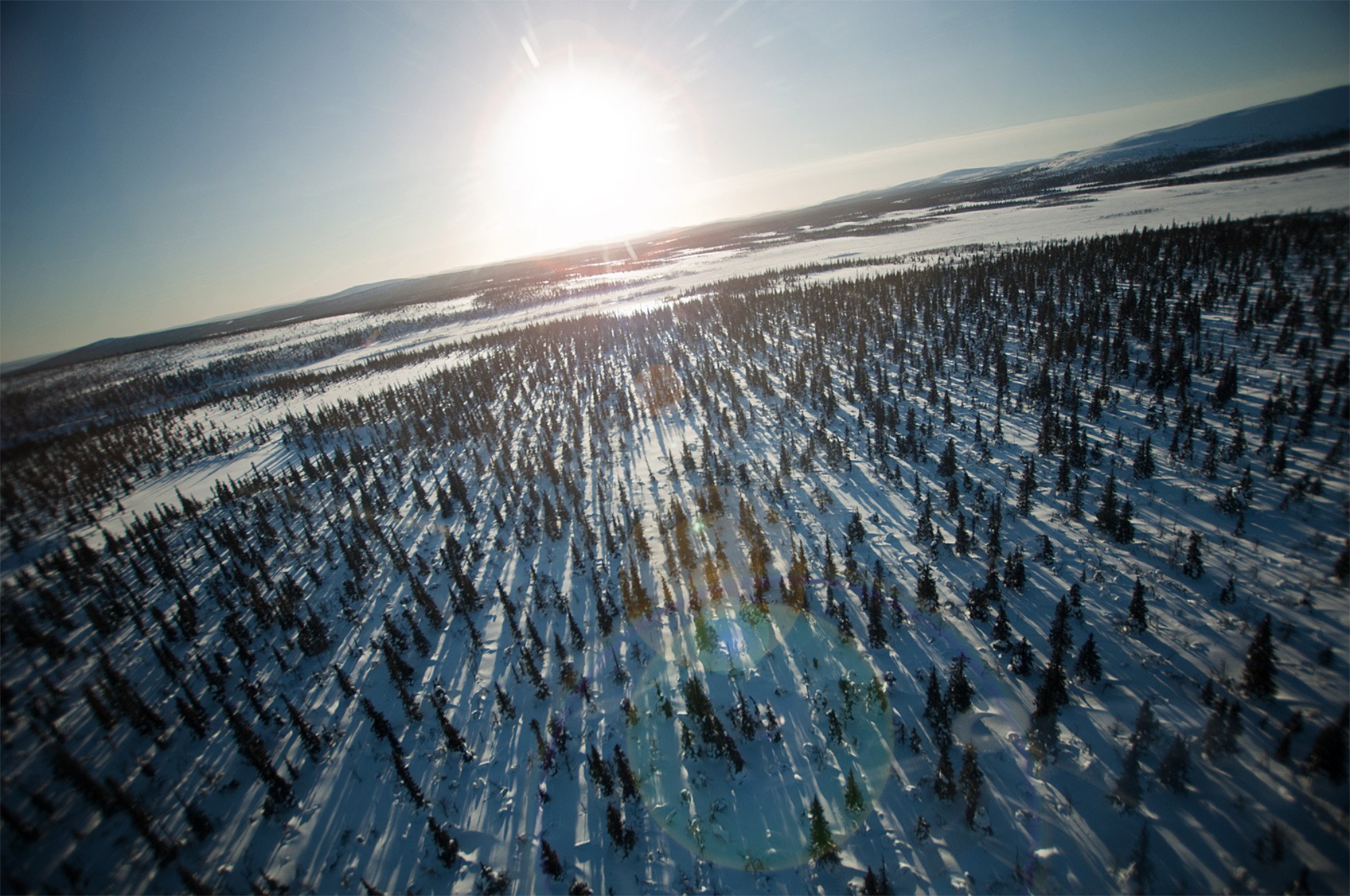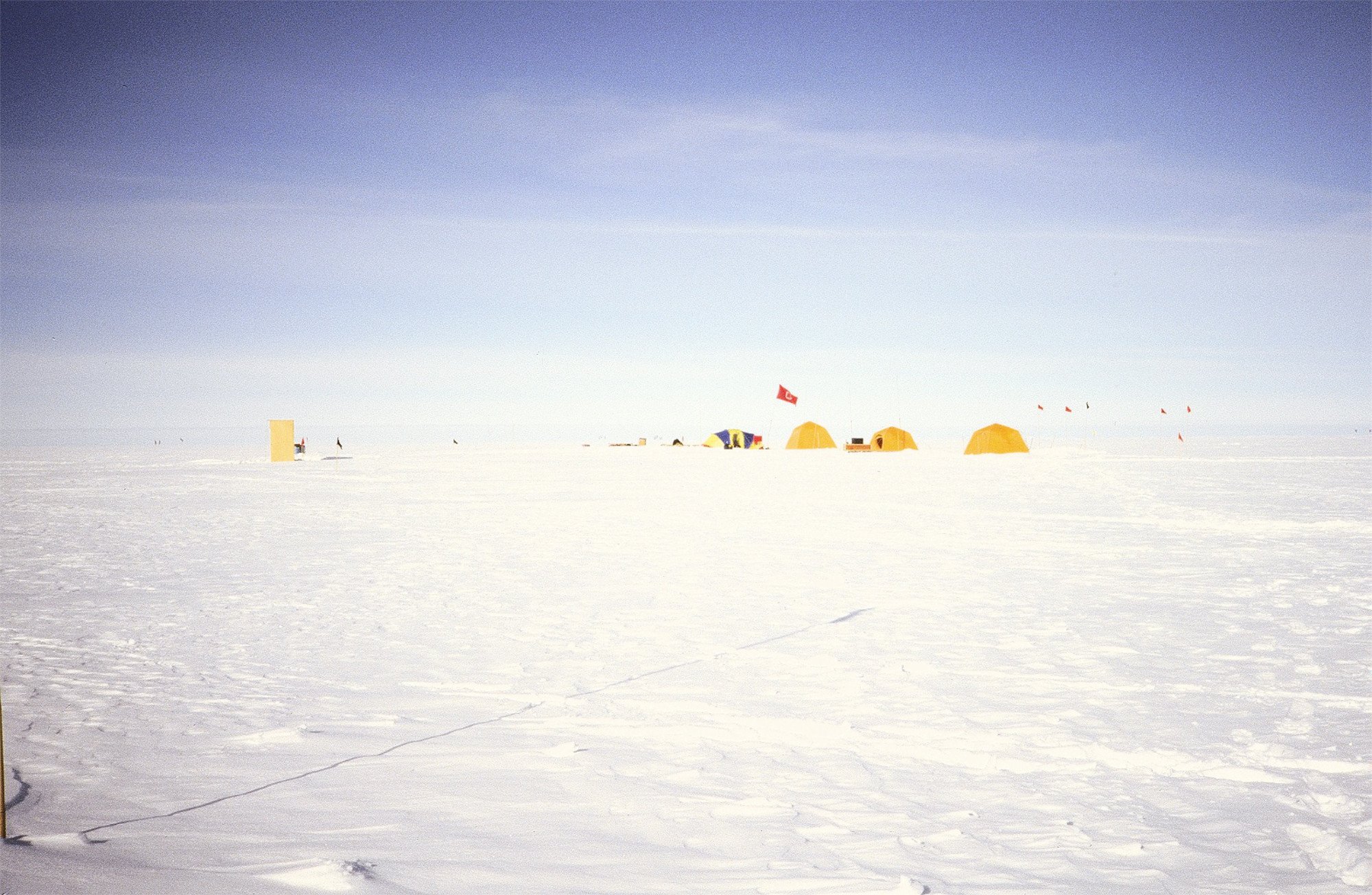Goodbye, Greenland
Aerial view of a glacier streaming out from the Greenland ice sheet, 1995. Photo: Ingrid Zabel
Dr. Ingrid H. H. Zabel, Paleontological Research Institution, Ithaca, New York 14850
Published September 14, 2022.
I’ve had a romantic vision of the Arctic since childhood. Family stories are powerful, and one of ours is that my father was named after Roald Amundsen, a Norwegian polar explorer (despite my father’s family having no ties to Norway). My mother grew up in Sweden, and she instilled in me a deep appreciation for winter and snow. When my husband and I got married, we were fortunate to be able to spend part of our honeymoon backpacking above the Arctic Circle in Sweden. The Arctic did not disappoint with its lonely, quiet beauty.
Forest in Sarek National Park, Sweden. Photo by Michiel van Nimwegen, CC BY-NC-ND 2.0 via Flickr.
How lucky was I then when I got to work in the Arctic! In the early 1990s I was part of a research team at The Ohio State University’s Byrd Polar Research Center, studying the way that radar beams interact with snow and ice on the Greenland ice sheet. This was to help scientists better interpret images of the ice sheet that were generated by satellite-borne radar instruments, looking down at the Earth to try to understand how the Greenland ice sheet was changing as the climate warmed.
Working on the ice sheet in Greenland, I was once again caught up in the romance of the Arctic. Being on the ice sheet felt like being in the ocean with no land in sight in any direction. It was exciting living in a tent, melting snow for drinking water, and searching for news from the BBC World Service on my shortwave radio.
Our camp in Greenland, 1993. Photo: Ingrid Zabel
I also loved the periods of time that we spent on the coast before and after going out on the ice. Here I got a glimpse of the outside of Greenlanders’ homes, with sleds and racks of drying fish in the front yards. I found musk ox fur on the branches of shrubs that I hiked through, and saw icebergs calving into the sea from the Ilulissat (Jakobshavn) Glacier, the fastest moving glacier in the world.
Houses in Ilulissat, Greenland, 1995. Photo: Ingrid Zabel
At the time I did this work, I was caught up in the romance of being in a place that was so different from anything I had known before, and in the excitement of scientific research that I considered very important. I’m ashamed to look back and realize that I wasn’t thinking much at the time about the impact that the melting of the Greenland ice sheet would have on people around the world, although I knew it would contribute to sea level rise. Now I think about that impact a lot, and I am very scared.
What must it feel like to live near the ocean and know that it’s rising upward and inward toward you? One doesn’t have to go halfway around the world from Ithaca, NY to find out. This account written in 2017 by journalist Nathan Kensinger [1] comes from Hamilton Beach, a neighborhood in Queens, NY.
Every month during the highest tides, the streets of this small Queens community are flooded by the waters of Jamaica Bay. At first, as the saltwater starts to trickle in from Hawtree Creek, the small puddles forming around curbs and storm drains don’t appear to be so bad. But as the tide continues to rise, the roads are quickly submerged.
Soon, tiny fish begin to swim across the concrete, and the water is above your ankles. Then swans start to paddle into empty lots, and the water has reached your calves. Suddenly, the flooding is knee high, and the nearest dry land is much too far away. It is a deeply disconcerting feeling, to be standing in seawater in the middle of a neighborhood.
Yet for those living in Hamilton Beach, and in many other neighborhoods around the city, street floods like this are a regular, everyday occurrence. “This is nothing,” says Ginny Dunker, looking out from her front door at a recent six-and-a-half-foot high tide that had flooded midway up her block. “Come back on a rainy day, and then you will see something.”
Disturbingly, the news about sea level rise is increasingly grim. In its 2021 assessment of global climate change, the Intergovernmental Panel on Climate Change (IPCC) concluded that
“It is virtually certain that global mean sea level will continue to rise over the 21st century.”
and
“In the longer term, sea level is committed to rise for centuries to millennia due to continuing deep-ocean warming and ice-sheet melt and will remain elevated for thousands of years (high confidence).” [2]
Even more disturbingly, a just-published study [3] has concluded that no matter what actions we take, the Greenland ice sheet’s contribution to sea level rise by the end of the 21st century will be at least 10.8 ± 2.7 inches (27.4 ± 6.8 cm) – from warming that has already taken place.
This is a staggering scientific prediction. It says that almost a foot of sea level rise is going to happen no matter what we do—just from the Greenland ice sheet—and “at least” means this is the minimum projection, so the end result could very well be higher. Although this projection is just one study, it is generally consistent with others, and it is hard to overstate what this means. The implications are enormous. This amount of sea level rise will flood a huge amount of the most densely-populated areas on Earth, and greatly worsen regular flooding of the sort that people are experiencing in Queens and elsewhere. It will greatly increase the disastrous effects when a storm hits, leading to higher storm surges with more water being pushed onto land. These storm surges don’t just affect the coast, but also often heavily-populated river systems that empty out to the ocean. This is not an indistinct and indefinite “someday”; it is more like “this is almost certainly going to happen, and soon”.
People impacted by flooding in Jakarta, Indonesia, from overflow of the Sunter River, one of several rivers flowing through Jakarta that meet the ocean in Jakarta Bay. Photo by World Meteorological Organization (CC BY-NC-ND 2.0) via Flickr
What’s going on?
Sea level is rising because meltwater and ice from the Greenland and Antarctic ice sheets, as well as meltwater from mountain glaciers around the world, are pouring into the ocean. It’s also rising because the ocean is heating up, and warm water expands. When that happens, the only way for the water to go is up. The ocean has absorbed a tremendous amount of heat energy as we’ve been warming the atmosphere over the last hundred years or so by burning fossil fuels. And because the ocean is so large and has such a high heat capacity, it responds very slowly to this input of heat (that is, slow relative to the time scale of human lifetimes). You may be familiar with the high heat capacity of water from observing that it takes a lot of heat energy to boil a pot of water, which then remains hot long after the heat source is removed. Ice sheets like the ones that cover Greenland and Antarctica also respond slowly. The slow response of the ocean and ice sheets is why sea level will continue to rise for such a long time, even after we reduce our greenhouse gas emissions.
Learn about the heat capacity of water in “Feel the Heat Capacity” by Paleontological Research Institution (YouTube)
If coastal areas around the world are facing hundreds of years of rising seas—and thousands of years of high seas—does that mean we should give up? No! As my PRI colleague Don Haas has written, “It’s too late. Let’s get to work anyway.” We can still lower the magnitude of future sea level rise by cutting our greenhouse gas emissions. If you were a city planner or disaster manager, would you rather have to deal with sea level that is 1.5 feet (0.5 m) higher than at the end of the last century, or 6 feet (2 m) higher? Certainly 1.5 feet is a calamity for some places, but it is more manageable than 6 feet.
Here in the U.S., where our way of living has made us the biggest contributor to global carbon dioxide emissions in the last 150 years—almost 30% of cumulative emissions worldwide [4]— we have a special responsibility to take action. And taking action will help us beyond reducing sea level rise. Reducing our greenhouse gas emissions will reduce other impacts of climate change that can be turned around, leading to a future with fewer intense heat waves and heavy rainfalls instead of more of them. This will make it easier to focus our resources on adapting to a future with higher seas. It is late, but not too late.
I last said goodbye to Greenland in 1995, and I’ve always wanted to go back. I’ve thought of walking out again from the town of Ilulissat, past the cemetery, to a rocky ledge where I could see icebergs floating out to the sea. But even if I could travel there, I can’t go back to that place as it was, because it has been forever changed. The terminus (end) of the glacier where the ice meets the sea has retreated backward more than 6 miles (10 km) as the world has warmed.
It’s never wise to expect that special places from our past won’t change, but we can wish it. I just wish this place hadn’t changed so much from all of us heating up the Earth.
Icebergs that had broken off from the Ilulissat Glacier in Greenland, 1995. Photo: Ingrid Zabel
The thought of a world with a long-term future of higher seas is overwhelming. How are we going to cope with this? The challenge is indeed daunting, but I still have hope. Is that because I live inland, so I’m not affected by sea level rise in my everyday life? Maybe. But I have no illusions that we won’t all pay financially to protect the people on the coast, and that we won’t be affected by migration of people whose communities have been inundated. I have hope for three reasons: 1) because I’m taking action by trying to reduce my own and my community’s emissions, 2) because I work in education and I see how growing understanding of climate change motivates people to take action, and 3) because I see the many positive actions of others on local, state, national, and international levels.
I still have hope. The time is short, but we can still make a big difference!
Thank you to Warren Allmon for his review.
References
Nathan Kensinger, In Queens, chronic flooding and sea-level rise go hand in hand, Curbed New York, October 12, 2017. https://ny.curbed.com/2017/10/12/16462790/queens-climate-change-jamaica-bay-flooding-photos accessed Sep. 2, 2022. Thank you to Allison Chatrchyan for the reference.
IPCC, 2021: Summary for Policymakers. In: Climate Change 2021: The Physical Science Basis. Contribution of Working Group I to the Sixth Assessment Report of the Intergovernmental Panel on Climate Change [Masson-Delmotte, V., P. Zhai, A. Pirani, S.L. Connors, C. Péan, S. Berger, N. Caud, Y. Chen, L. Goldfarb, M.I. Gomis, M. Huang, K. Leitzell, E. Lonnoy, J.B.R. Matthews, T.K. Maycock, T. Waterfield, O. Yelekçi, R. Yu, and B. Zhou (eds.)]. Cambridge University Press, Cambridge, United Kingdom and New York, NY, USA, pp. 3−32. https://www.ipcc.ch/report/ar6/wg1/ accessed Sep. 2, 2022
Box, J. E. et al. Greenland ice sheet climate disequilibrium and committed sea-level rise. Nat. Clim. Chang. 1–6 (2022) doi:10.1038/s41558-022-01441-2, accessed Sep. 3, 2022
Hannah Ritchie, Who has contributed most to global CO2 emissions? Our World in Data, October 1, 2019. https://ourworldindata.org/contributed-most-global-co2 , accessed Sep. 9, 2022.







